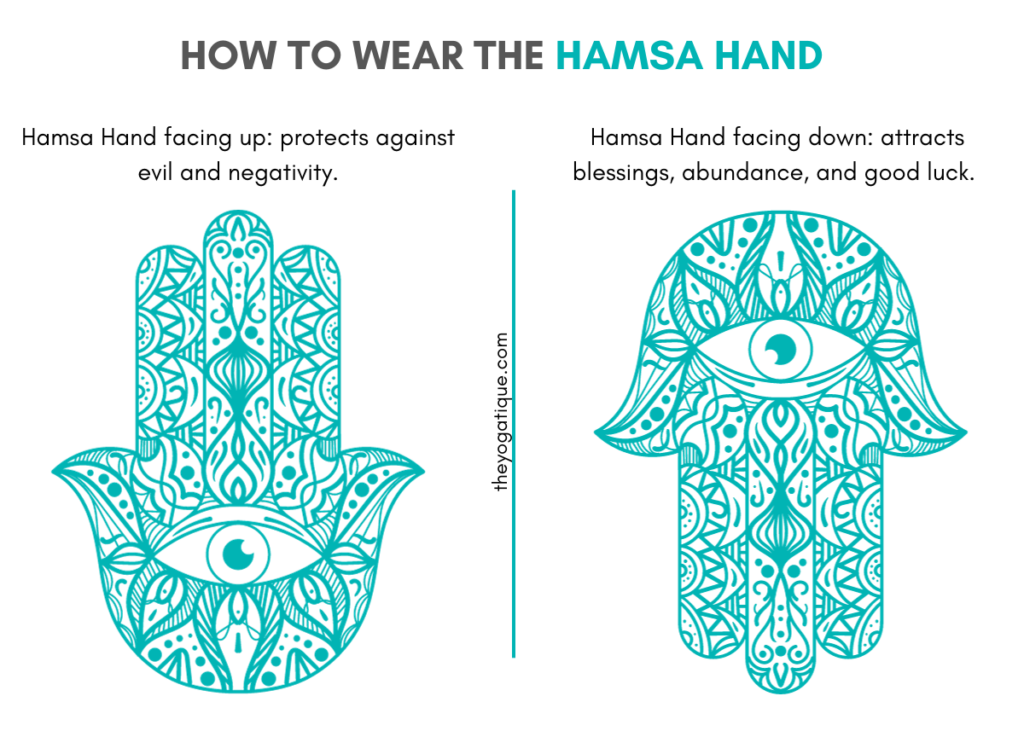Like me, you’ve probably come across the beautiful Hamsa Hand symbol in your yoga studio. Or perhaps you’ve been gifted Hamsa jewelry and have wondered about its meaning. The Hamsa hand is linked to yoga and Hinduism, but it’s actually a symbol of universal resonance.
This powerful amulet transcends all cultural boundaries, embraces various religions, and is just as beneficial today as it was in ancient times.
Come journey with us as we trace its origins to unravel how the Hamsa Hand can enrich our spiritual practices and daily lives.
Article content:
(Click any link below to jump directly to section)

THE YOGA TEACHER TRAINING
YOU'VE BEEN LOOKING FOR.
Online Yoga Teacher Training Offers
- Affordability
- Flexibility
- Certification
- Lifetime access
⬇Click below to discover the best Yoga Alliance registered online yoga certifications enrolling now⬇
Hamsa Hand origin
The Hamsa is attributed to both Judaism and Islam, but its origin goes back even further.
The Hamsa Hand symbol was found in artifacts in ancient Mesopotamia (a historical Middle East region). It is also linked to the goddess Tanit, a Phoenician lunar goddess worshiped by the people of Carthage (modern-day Tunisia) in 800 BC.
Today the Hamsa is commonly seen worldwide, where it is used in various cultures as a symbol of protection against negativity and the “evil eye”. It also represents blessings and is believed to hold magical properties to attract good fortune.
While the Hamsa Hand does not originate from Buddhism, it is often used by Buddhists and Hindus, which is how it found its way into the world of yoga and meditation.
Hamsa is also a Sanskrit word meaning “white swan.” In Hindu beliefs, the white swan represents the divine Spirit.
The Hamsa hand meaning in yoga
In yoga, Hamsa represents the “life force,” or energy flow that we access through our breath. Kundalini yoga teaches that the awareness of this breath awakens the serpent energy at the base of the spine and sends it soaring up the spine like a bird taking flight.
There are several associations between the hand of Hamsa meaning and yoga.
First, the five fingers of the Hamsa Hand represent the first five chakras of the subtle body and the five elements.
Hamsa meaning in Judaism
The word Hamsa comes from the Hebrew word Hamesh, which means “five” and represents the fifth letter of the Hebrew alphabet.
The Hamsa was popular in Jewish culture during the late nineteenth and early twentieth centuries. It is typically referred to as “the hand of Miriam” because it symbolizes the sister of Moses and Aaron.
Many Jews believe the five fingers of the Hamsa Hand represent the five senses a person needs to worship god. Judaism even has a “Hamsa prayer” linked to this symbol, used to evoke positive energy, happiness, hope, and peace.
Hamsa meaning in Christianity
In Christianity, the Hamsa represents the Virgin Mary, the mother of Jesus Christ. Thus, it is commonly known as the Hand of Mary in Christianity. While the Hamsa Hand is not a traditional symbol in Christianity, it does have a unique meaning among Christians.
Representing mother Mary, some Christians wear this symbol or place it in their home to invoke her protective powers. However, it is worth noting that many Christians have mixed feelings about the Hamsa Hand as the opposing religions of Islam and Judaism use it. Thus, most Christians prefer to wear other religious symbols like the cross.
Hamsa meaning in Islam
In the Islamic faith, the Hamsa Hand is known as the Hand of Fatima, after the daughter of the prophet Mohammed. It is also sometimes referred to as the Hand of Khamsa; Khamsa is an Arabic word meaning “five,” referring to the five pillars of Islam; faith, prayer, alms, fasting, and pilgrimage.
In modern-day times, the Hamsa Hand remains popular in Muslim culture. However, it is more of a cultural symbol than a religious one as it is not mentioned in the Quran or Hadith.
Along with being a protective symbol against bad luck and negative energy, in many parts of the Middle East, the hand of Hamsa meaning is a symbol of Fatima. Also referred to as the “woman’s holy hand” it represents Fatima’s positive qualities of benevolence, fidelity, and purity.
Hand of Fatima story
Fatima Az-Zahra, whose name means “the luminous one” in Arabic, was the daughter of the founding prophet of Islam, Muhammad.
Fatimah is a highly revered figure in Islam, so many stories exist about her. One well-known tale is about Fatimah's protection of her father. When Muhammad meditated in the cave of Hira to receive the teachings that would become the Quran, Fatimah brought him food and water and tended to his needs.
One version of the story states that when enemies of Muhammad approached the cave in an attempt to harm him, Fatimah stood at the entrance with her arms outstretched, forming a protective shield. This is where the Hamsa Hand and Fatimah's symbolic reference originates.
Hand of Fatima significance
The Hamsa appearance differs across cultures, and many artists add their own minor interpretations to the symbol. However, the Hamsa Hand symbol typically shows an open hand with an eye in the center.
In many religions, the open hand represents the Hand of God, providing blessings, protection, health, and guidance to the wearer. The hand may sometimes be closed, bringing good luck rather than warding off evil.
The eye is sometimes called the “eye of God” or the “all-seeing eye,” symbolizing divine awareness and protection. However, it can also represent the “evil eye” that it offers protection against.
How to wear the Hand of Hamsa
If you decide to wear the Hamsa Hand, understand the difference between the hand facing up and down before buying Hamsa jewelry or clothing. The Hamsa symbol has different meanings depending on its positioning, similar to the Unalome symbol. Here are the key differences between it facing up or facing down:
- Facing down: Brings blessings, abundance, and good luck. It can also increase fertility and amplify your manifestation potential.
- Facing Up: Its a universal sign against evil and negativity. In modern times, wearing the Hamsa Hand facing up can ward off negative thoughts and protect you from absorbing the negative energies of others.
The Hand of Hamsa is not associated with any one religion or mentioned in any religious text, so anyone who feels a connection to this symbol can wear it.
However, like many other sacred emblems such as the Om symbol, the Hamsa Hand is sometimes worn by people as purely a fashion accessory. In fact, nowadays, you will spot this distinct symbol on many t-shirts, jewelry, and other accessories.
In my opinion, if you understand and resonate with the Hamsa symbol, there is no reason why you cannot wear Hamsa jewelry. However, it may be seen as culturally insensitive to some people if you wear the Hamsa as a fashion statement without knowing its origin and meaning.

Where to place a Hamsa Hand in your home
The best place to put a Hamsa Hand is at the main entrance of your home, such as the front door or the gate to your property. This placement may prevent negative energy from entering your home.
You may also like to place it in your main living space (where the family spends the most time) or hang it over your bed for protection while you sleep. Just like the Om symbol, the Hamsa Hand is very versatile.
Another nice spot to put a Hamsa Hand is a yoga room or meditation altar. Doing so will allow you to call on its protective and peaceful qualities during your spiritual practices and help you connect to this symbol on a deeper level.
Moreover, due to its links with the subtle body, meditating with the Hamsa Hand may help you balance your energetic centers and align with the five elements.
Takeaway on the meaning of the Hamsa symbol
If there is one symbol that holds a unique power to bridge cultures and span various major religions, it is the hand of Fatima. The traditional Hamsa symbol meaning may be of protection, good fortune, and positivity, but by looking at its history, we can see that it also represents inclusivity and unity.
So, if you're looking for a universal symbol that embodies the essence of yoga, this is it!
Some online yoga studios, online yoga teacher training programs, and brands that we write about may offer us a small percentage should you decide to purchase after reading our content. Thank you for enabling us to exist!









